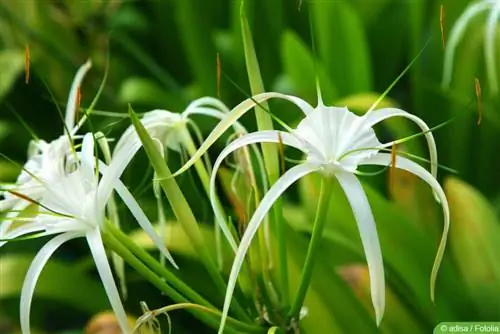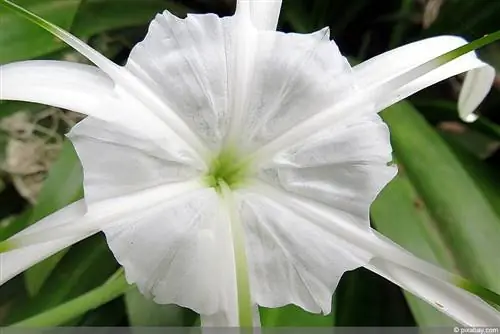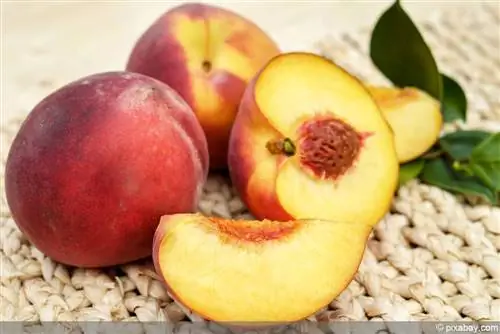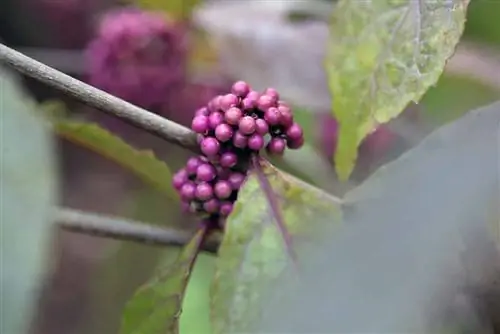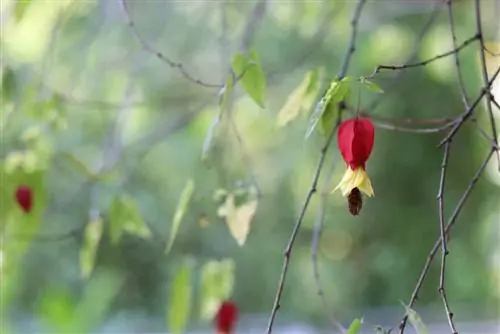- Author admin [email protected].
- Public 2023-12-17 03:39.
- Last modified 2025-06-01 06:48.
Hymenocallis or hymenocallis give the hobby garden an exotic touch. Because its large flowers have delicate, filigree petals that are up to 25 centimeters wide. Although the exotic bloomers come from South America, they are also easy to cultivate in the home garden, as well as in pots on the balcony or terrace, as long as they get plenty of light.
Profile
- Botanical name: Hymenocallis
- Species: 50 to 65 species
- Plant family: Amaryllis family
- Synonyms: Ismene, beautiful lily, spider lily, Peruvian lily
- Growth height: 45 to 80 centimeters
- Flower: umbel-shaped, mostly white, large (up to 25 centimeters wide), fragrant, delicate, filigree petals
- Flowering time: end of June / beginning of July - August / September
- Leaves: tongue-shaped or obovate-lanceolate, dark green
Location
Although the beautiful skin loves the sun, it can also tolerate a partially shaded location. Ideally the location offers afternoon sun. However, bright midday sun should be avoided as the fleshy leaves react sensitively to strong sunlight. Some varieties can also be grown in a shady spot. When planting in the garden, it is important that the location
- protected
- without drafts
- without cold winds
is. Since the Ismenes love warmth, you can also place them on the wall of the house as this gives off additional heat. The location on the balcony should also provide light and be protected. As a houseplant, Hymenocallis needs a lot of light, so the location should be at least partially sunny. A spot by the south window is ideal.
Tip:
If the blinds are closed all day in summer, then the Ismene needs another, sunny location.
Soil and substrate
Ismene has no special demands on the soil as it can cope with any garden soil. A floor that is ideal is
- permeable
- moderately fertile and
- not too wet
is. When growing in pots, you should use high-quality potting soil or a sand-clay mixture.
Plants
If Hymenocallis is to be kept in the garden, the bulbs may only be planted out when frost is no longer expected. The following key data serves as orientation:
- Planting time: early to mid-May
- Daytime temperature: permanently between 12 and 15 degrees Celsius
- Planting depth: 8 to 10 centimeters
- Onion base can be just above the ground.
- Planting distance: 15 to 20 centimeters
- approx. 16 plants per square meter
- water after planting
Tip:
You can grow Ismenen in the house or greenhouse from April.
If it is grown in a pot or bucket, the plant works best if you place three bulbs together in the planter. However, make sure that the distance between the plants is large enough.
Care
Beautiful skin is easy to care for. Since they produce very large flowers, fertilizing is one of the most important care measures. In addition, the soil or substrate should never dry out completely. But be careful, the exotics cannot tolerate waterlogging.
Pouring
Whether planted in the garden or cultivated in a pot, the summer bloomers cannot tolerate waterlogging. Therefore, you should not plant them in damp locations. If in doubt, choose a rather dry location. When keeping it in a pot, you should choose a pot with at least one drainage hole so that excess water can drain away. If water remains in the saucer, remove it approximately ten minutes after watering.

It is also recommended to create a drainage layer made of broken clay and/or gravel at the bottom of the planter. This means excess water drains away more quickly.
Watering also depends on the stage of development the plant is in:
- water regularly and moderately until the inflorescence develops
- if the inflorescence appears, then water a little more
Watering occurs when the surface of the soil or substrate is slightly dry. The soil should always be slightly moist and never dry out completely. In the fall you should slowly reduce watering. If the beautiful skin pulls in its leaves, watering is no longer carried out.
Fertilize
Since Hymenocallis produces very large flowers, it needs a lot of nutrients. So it needs to be fertilized. Once planted in the garden, the fertilizer period begins approximately six weeks after planting. Fertilize weekly with a normal liquid fertilizer or a flower fertilizer. Ismenes that are kept in pots or buckets receive a long-term fertilizer in the form of sticks or granules in the spring. Alternatively, you can give the summer flowering flowers in containers a liquid fertilizer every month from April to August.
Tip:
Beautiful plants that have just been repotted do not need any additional fertilizer in the year of repotting, as the potting soil is usually pre-fertilized.
Cutting
Ismene doesn't need a shape, back or training cut. The above-ground parts are only cut off when they have completely wilted in autumn and the bulbs move to winter quarters. However, you can also place the flowers with their long stems in the vase as cut flowers. However, you have to expect a significantly shortened flowering period.
Repotting
Since the bulbs are dug up every year, the classic form of repotting is no longer necessary, as they go into fresh substrate after the winter rest.
Wintering
Since Hymenocallis is not hardy, it cannot survive the German winter outdoors, not even in pot culture on the balcony or terrace. That's why the plants, more precisely the bulbs, have to overwinter inside. You should plan for the plant to need a rest period of three to six months. Basically, the outdoor season ends before the first frost. However, you should only dig up the bulbs when the above-ground parts of the plant have completely wilted. The onion draws nutrients from them that it needs for overwintering. In preparation for winter rest, watering is gradually reduced in autumn.
When the time has come to dig up the bulbs, proceed as follows:
- Cut off above-ground parts if still present
- Dig up the onions carefully
- Do not damage roots and bulb
- Allow the onions with the soil attached to them to dry in the dark (on newspaper, never in direct sunlight)
- Do not remove brood and daughter onions from the mother onion
- after drying: carefully remove loose soil
- leave tight soil on the bulb (avoiding damage to the bulb and roots)
- Store onions in newspaper, wood shavings or wood litter over the winter
- Storage location: cool, dry, dark, free from drafts but well ventilated
- ideal temperature: 8 to 10 degrees Celsius
The winter rest ends in spring (March, April). Then the bulbs are placed in fresh substrate and can be placed in a warmer location. You can carefully shorten the roots a little and divide the bulbs for propagation. From mid-May, when frosts are no longer expected, you can plant the bulbs in the garden or put the pots on the balcony.
Tip:
As digging up the onions in the garden bed is often tedious, you can also bury them in the pot. The
makes digging easier in the fall.
Propagate
Since the beautiful skin is an onion flower, the simplest form of propagation is with brood or daughter bulbs. Propagation with seeds is possible, but is not recommended for hobby gardening.
Propagate with onions
Brood or daughter bulbs form naturally on the mother bulb. Since Hymenocallis finds interference with its root system disturbing, it is recommended to divide it after winter rest, but only if you want to propagate the plant. It is important that neither the bulbs nor the roots are damaged when dividing and planting. If the brood onions are separated from the mother onion, they can be cultivated independently. It is ideal if you grow the daughter bulbs in a pot in a bright location from April onwards. They come into the garden from mid-May, so that they are no longer affected by late frosts.
Tip:
It usually takes two to three years until the young Ismene have grown into stately plants and show their first flowers.
Propagate with seeds
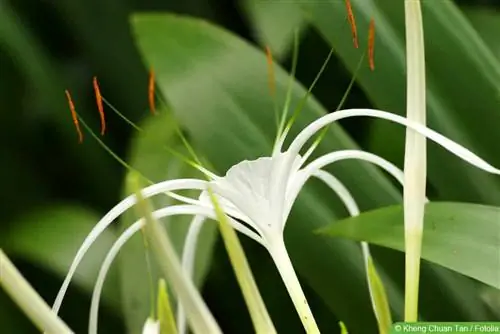
Propagation with seeds requires that the flowers form large, green capsule fruits. This is not the case with many hybrids. But little is known about other varieties as to whether they actually have the ability to reproduce. Once capsule fruits have formed, they contain large, green, fleshy seeds. Add these to potting soil in April. When seedlings develop, they can be separated and cared for like adult plants.
Diseases
Illnesses often result from care errors in beautiful skin, which usually lead to bulb rot. The reasons for this are too much water (waterlogging) or too much fertilizer (over-fertilization). In both cases, the damaged onion can no longer be saved.
Pests
The biggest enemy of the beautiful skin is voles. Other animal pests include the large daffodil fly (Merodon equestris) and aphids.
Voles
Voles like to eat the bulbs of Hymenocallis. Therefore, you should protect plants that are kept in the garden bed from these voracious enemies. Two variants have proven successful:
- planting in a pot
- Lay out wire mesh
Planting in a pot
In this variant, the onions go into the garden bed in the pot. You should avoid plastic pots and instead choose a pot made of a natural material, such as an unglazed clay pot.
Lay out wire mesh
In this variant, a wire mesh forms an underground fence that protects the plant from the voles. It is important that the wire mesh is extremely tightly meshed, such as rabbit wire. When creating the fence, proceed as follows:
- Dig a hole in the earth
- Size depends on the size of the onion
- Line the floor and walls with the wire mesh (leave no gaps)
- Cover wire mesh with soil
- insert onion
- fill with soil
Aphids
Unfortunately, this plague doesn't stop at the beautiful skin. You should therefore regularly check the ismenes, especially the stems, for infestation. Once the pests have settled in, spraying with nettle broth has proven to be effective. It is important that you repeat the process several times. Additionally, if weather permits, spray on a dry but overcast day. An alternative to spraying is the settlement of natural predators of the lice. These include ladybirds, lacewings and earwigs. If real colonies of pests have formed, you should cut off the affected parts of the plant.
Daffodil fly
The offspring of the daffodil fly are the actual pest. Because the female fly lays the eggs on the ground. Once the maggots have hatched, they penetrate the soil or substrate and migrate to the onion, which they use as food. An effective way to combat this pest is not yet known.
If you notice an infestation, he althy onions should not be planted in the same place next spring, then the insects will pupate in the soil and fly out in April. When growing in containers, you should dispose of the substrate and clean the pot very thoroughly when using it again.

